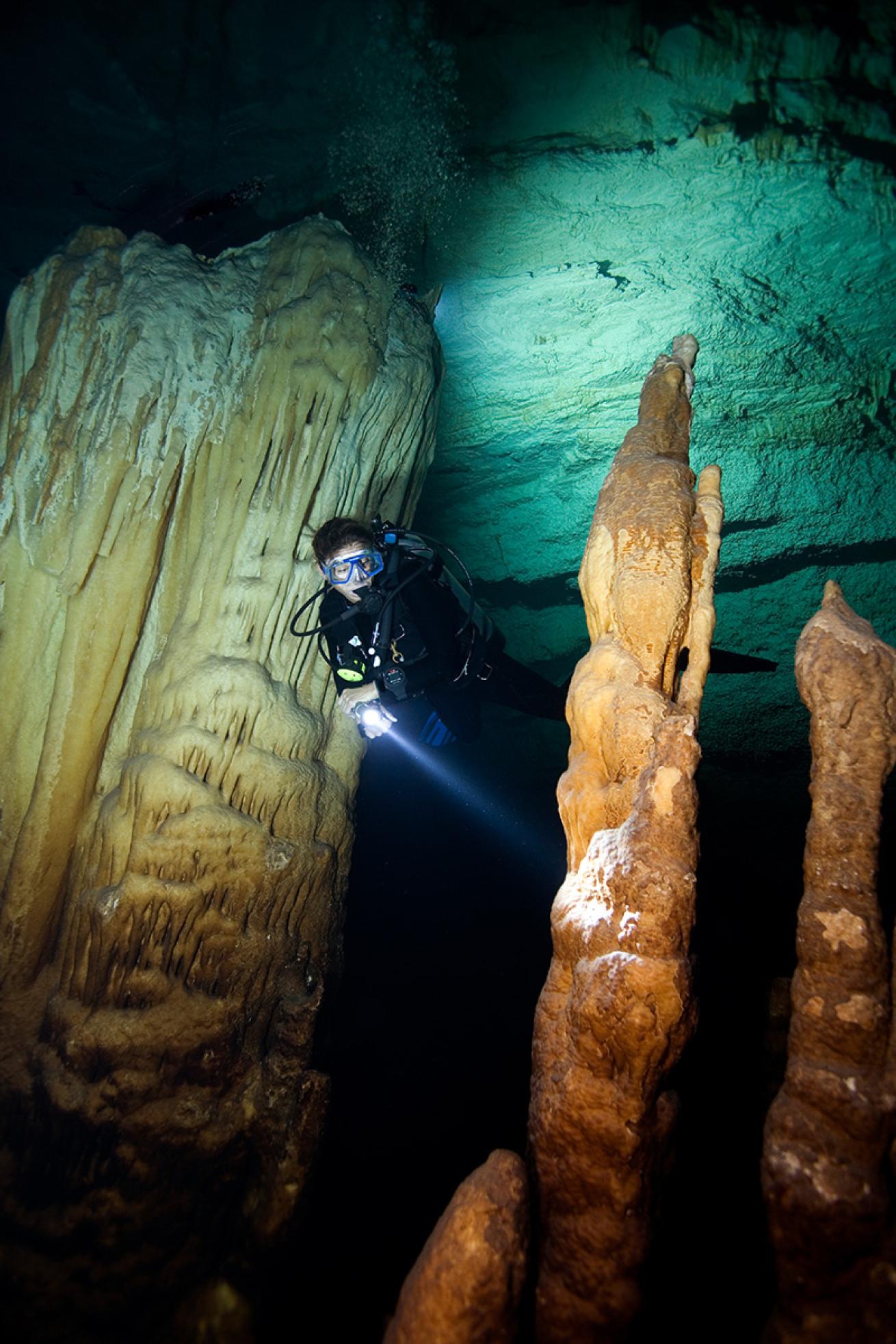Entering the Underworld: Cavern Diving in Grand Bahama
The earth gapes before me and I clamber down, Persephone on her way to Hades. Homer wrote the Underworld lay beyond the world’s western edge, but the Greeks used several portals to access the land of the dead: Lake Avernus, Alcyonian Lake, a cavern near Tenarus. And I’ve found another: Ben’s Cave in Grand Bahama’s Lucayan National Park.
My Charon is Shamie Rolle, owner of Calabash Eco Adventures. He leads me down the spiraling stairs to a dock next to the underground lake. Sleeping bats shift overhead. One wakes, taking flight into the sun that filters through the verdant foliage above us all. Its wings are the only noise as we turn our backs to the light and enter the water. The waterline rises above my mask. I look down at Shamie, who’s already headed toward the darkness below. We are spared Cerberus and have crossed Acheron, the river forever separating ancient Greece's living and dead.
Our world fades to a ghoulish teal as we swim toward the underwater cavern. Cool freshwater presses all around, fed underground and siphoned for drinking water. We move toward a column hewed in the last ice age. At one point, it stretched from the cavern’s ground to its roof, but in some unidentified past it snapped in half. The top crumbled to the ground, where its remnants still litter the floor.
I follow Shamie past stalactites toward the ancient column. Its black form turns to a honey mustard yellow under our flashlights’ beam. We circle upward and perch on the massive stone. As instructed before the dive, I look back toward the entrance.

Shutterstock.com/Image Source Trading LtdA diver swims through the freshwater portion of Ben's Cave.
I would have lost my breath if such things were allowed during scuba. The eerie emerald water frames the rocky terrain, a spectral spectacle. Topside life haunts the water, light penetrating as far as it can in a quickly lost battle. Before our descent, Shamie warned me that no image would capture the haunting beauty of the scene. And he is right—the vista flattens to cardboard with every click of my camera.
I want to stay here the entire dive, but a tap on my shoulder tells me it’s time to continue our journey. We continue deeper still.
Below, the cool water turns into a warm haze. We have reached the halocline, where the fresh groundwater sits above seeping saltwater and salt-eating bacteria living on this border leaves a spectral haze.
Sinking into the fog, the world instantly goes out of focus. My anxiety rises. Will I be able to see again during this dive? But I clear the halocline, sinking gratefully into the noticeably warmer water below. I bounce up and down, rinsing myself in freshwater, then salt. Then fresh, then salt. I forget my anxiety, forget the world above. We have passed through the waters of the Lethe, where all memories of the topside world washed away.
Here, Asphodel is a coral graveyard. Signs of this long-dead reef pockmark the walls. I see the memory of bivalves and conch sells, impressions of marine life gone by pressed into the stone. Millions of years ago, such shallow waters hosted a thriving community. These shallows are ultimately what gave the Bahamas their name: Baja mar, “shallow sea” in Spanish. Today, the clearest mark that remains is a proud brain coral fossil; Shamie points it out as we swim through a trench along the cavern’s edge on our return journey. The Lethe has not erased all remembrance.
Light returns slowly, gray replacing black, then azure overtaking. We pass back into the cool freshwater, a harsh return from the bathwaters of Asphodel. The cavern continues nine miles, but we turned far before the deepest Hadal realm of Tartarus.
Gray snapper mill about below the surface as we complete our return. My head surfaces, popping into a still quiet world. Bright midday light blasts into the cavern as water drips hypnotically and trees rustle above. It is spring again.
Need to Know
Operator: Calabash Eco Adventures
Cost: $140 per person, minimum group size four. Tanks, weights and national park entrance fee are included in the experience fee.
Equipment: A 5 or 7 mm wetsuit with hood is recommended. A flashlight is necessary. Equipment rentals are available from Grand Bahama Scuba for $10 per item through Calabash Eco Adventures.
Getting There: Calabash Eco Adventures will drive you the hour to and from Lucayan National Park. Accessing the cave requires walking a few minutes in your kit from the car to the cavern on uneven terrain, followed by a walk down a spiral staircase.
Topside: This experience includes a guided walk through Lucayan National Park after the dive, during which you experience Grand Bahama’s six ecosystems. A lunch stop is included in the tour at Banana Bay, a local restaurant. Meal cost is additional.
Where to Stay: Bahamas Hotel Search
Trip Tip: Do not wear lotion or sunblock for this dive; the water cannot be contaminated as it is an island drinking source.










